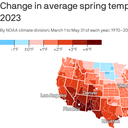Climate change is spurring a longer spring — with consequences

Spring is getting warmer on average nationwide, per a recent Climate Central analysis — a trend that reflects human-caused warming, the climate research group says.
Why it matters: Much of the seasonal climate change discussion is focused on summer and winter, when temperatures are typically at their annual high and low extremes. But the "between seasons" are affected, too.
The big picture: Average springtime temperatures warmed by 2.2°F from 1970 to 2023 across nearly 230 U.S. cities analyzed by Climate Central.
Stunning stat: Spring has gotten notably warmer in the American Southwest, where average seasonal temperatures have risen by more than 6°F in some places.
Zoom in: The highest average springtime temperature increases were seen in Reno, Nevada (+6.8°F); El Paso, Texas (+6.3°F); and Las Vegas (+6.2°F).
What it did: The group's analysis is based on National Oceanic and Atmospheric Administration data and looks at meteorological spring, which begins March 1 and ends May 31.
What it's saying: Warmer springtime temperatures cause a variety of knock-on effects, per Climate Central, including earlier snowmelt (which in turn affects drinking water supplies), longer allergy seasons, changes in agricultural growing seasons and more.